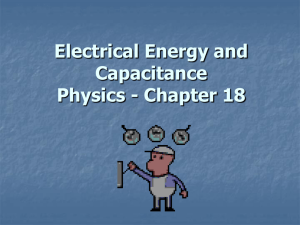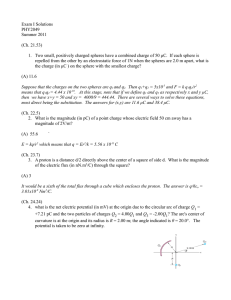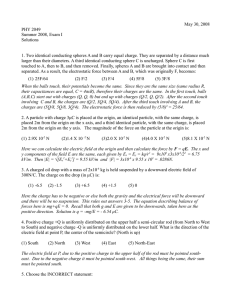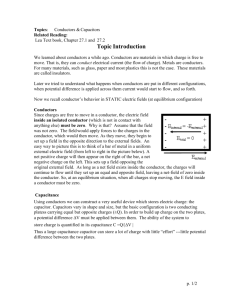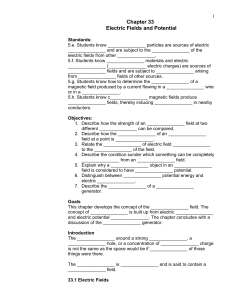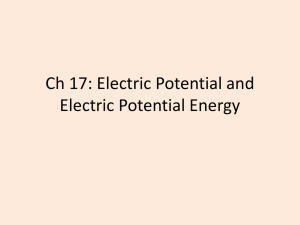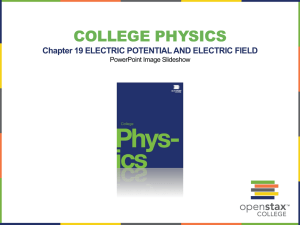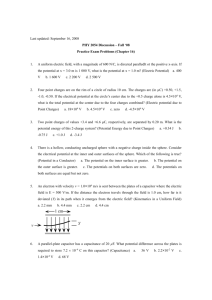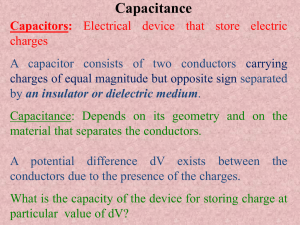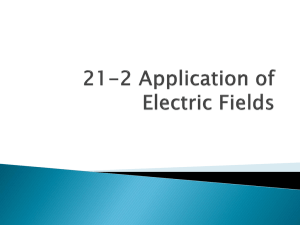PPT
advertisement
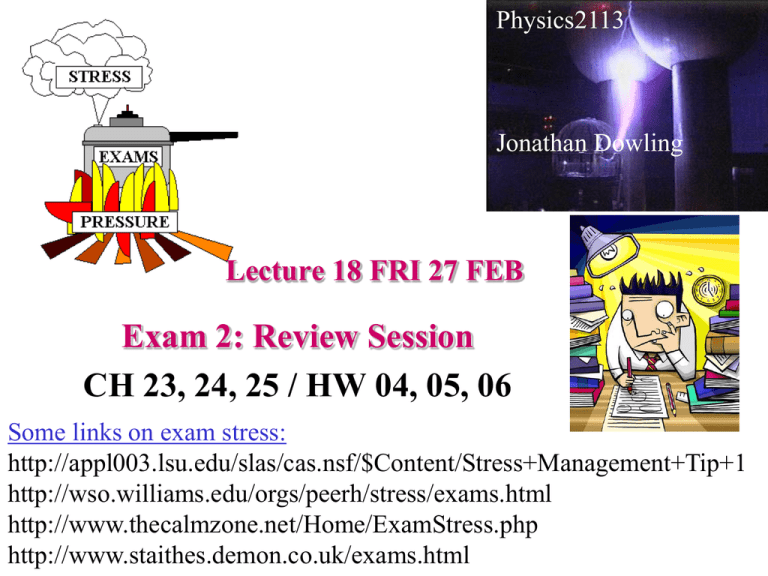
Physics2113 Jonathan Dowling Lecture 18 FRI 27 FEB Exam 2: Review Session CH 23, 24, 25 / HW 04, 05, 06 Some links on exam stress: http://appl003.lsu.edu/slas/cas.nsf/$Content/Stress+Management+Tip+1 http://wso.williams.edu/orgs/peerh/stress/exams.html http://www.thecalmzone.net/Home/ExamStress.php http://www.staithes.demon.co.uk/exams.html Exam 2 • (Ch23) Gauss’s Law • (Ch24) Sec.11 (Electric Potential Energy of a System of Point Charges); Sec.12 (Potential of Charged Isolated Conductor) • (Ch 25) Capacitors: capacitance and capacitors; caps in parallel and in series, dielectrics; energy, field and potential in capacitors. • Gauss’ law: =q/0 . Given the field, what is the charge enclosed? Given the charges, what is the flux? Use it to deduce formulas for electric field. • Electric potential: • • • • • – What is the potential produced by a system of charges? (Several point charges, or a continuous distribution) Electric field lines, equipotential surfaces: lines go from +ve to –ve charges; lines are perpendicular to equipotentials; lines (and equipotentials) never cross each other… Electric potential, work and potential energy: work to bring a charge somewhere is W = –qV (signs!). Potential energy of a system = negative work done to build it. Conductors: field and potential inside conductors, and on the surface. Shell theorem: systems with spherical symmetry can be thought of as a single point charge (but how much charge?) Symmetry, and “infinite” systems. Gauss’ law At each point on the surface of the cube shown in Fig. 24-26, the electric field is in the z direction. The length of each edge of the cube is 2.3 m. On the top surface of the cube E = -38 k N/C, and on the bottom face of the cube E = +11 k N/C. Determine the net charge contained within the cube. [-2.29e-09] C Gauss’s Law: Cylinder, Plane, Sphere Problem: Gauss’ Law to Find E Gauss’ law A long, non conducting, solid cylinder of radius 4.1 cm has a nonuniform volume charge density that is a function of the radial distance r from the axis of the cylinder, as given by r = Ar2, with A = 2.3 µC/m5. (a)What is the magnitude of the electric field at a radial distance of 3.1 cm from the axis of the cylinder? (b)What is the magnitude of the electric field at a radial distance of 5.1 cm from the axis of the cylinder? The figure shows conducting plates with area A=1m2, and the potential on each plate. Assume you are far from the edges of the plates. • What is the electric field between the plates in each case? • What (and where) is the charge density on the plates in case (1)? • What happens to an electron released midway between the plates in case (1)? Electric potential, electric potential energy, work In Fig. 25-39, point P is at the center of the rectangle. With V = 0 at infinity, what is the net electric potential in terms of q/d at P due to the six charged particles? Derive an expression in terms of q2/a for the work required to set up the four-charge configuration of Fig. 25-50, assuming the charges are initially infinitely far apart. The electric potential at points in an xy plane is given by V = (2.0 V/m2)x2 - (4.0 V/m2)y2. What are the magnitude and direction of the electric field at point (3.0 m, 3.0 m)? Potential Energy of A System of Charges • 4 point charges (each +Q) are connected by strings, forming a square of side L • If all four strings suddenly snap, what is the kinetic energy of each charge when they are very far apart? • Use conservation of energy: – Final kinetic energy of all four charges = initial potential energy stored = energy required to assemble the system of charges +Q +Q +Q +Q Do this from scratch! Don’t memorize the formula in the book! We will change the numbers!!! Potential Energy of A System of Charges: Solution • No energy needed to bring in first charge: U1=0 +Q +Q +Q +Q • Energy needed to bring 2 kQ in 2nd charge: U = QV = 2 1 L • Energy needed to bring in 3rd charge = kQ 2 kQ 2 U 3 = QV = Q(V1 + V2 ) = + L 2L • Energy needed to bring in 4th charge = 2kQ 2 kQ 2 U 4 = QV = Q(V1 + V2 + V3 ) = + L 2L Total potential energy is sum of all the individual terms shown on left hand side = kQ 2 L (4 + 2 ) So, final kinetic energy of each 2 charge = kQ 4L (4 + 2 ) Potential V of Continuous Charge Distributions r = R¢ 2 + z 2 kdq dV = r V = ò dV Straight Line Charge: dq= dx =Q/L Curved Line Charge: dq= ds =Q/2R Surface Charge: dq=dA =Q/R2 dA=2R’dR’ Potential V of Continuous Charge Distributions Curved Line Charge: dq= ds =Q/2R Straight Line Charge: dq= dx =Q/L Potential V of Continuous Charge Distributions Surface Charge: dq=dA =Q/R2 dA=2πR’dR‘ Straight Line Charge: dq= dx =bx is given to you. Capacitors E = /0 = q/A0 E =Vd q=CV Cplate = 0A/d Connected to Battery: V=Constant Disconnected: Q=Constant Cplate = 0A/d Csphere=0ab/(b-a) C= • • • Isolated Parallel Plate Capacitor: ICPP Q e0 A V = d A parallel plate capacitor of capacitance C is charged using a battery. Charge = Q, potential voltage difference = V. Battery is then disconnected. If the plate separation is INCREASED, does the capacitance C: • Q is fixed! (a) Increase? • d increases! (b) Remain the same? • C decreases (= 0A/d) (c) Decrease? • V=Q/C; V increases. If the plate separation is INCREASED, does the Voltage V: (a) Increase? (b) Remain the same? (c) Decrease? +Q –Q Parallel Plate Capacitor & Battery: ICPP • A parallel plate capacitor of capacitance C is charged using a battery. • Charge = Q, potential difference = V. • Plate separation is INCREASED while battery remains connected. • V is fixed constant by battery! Does the Electric Field Inside: • C decreases (= A/d) 0 (a) Increase? • Q=CV; Q decreases • E = σ/0 = Q/0A decreases (b) Remain the Same? (c) Decrease? Battery does work on capacitor to maintain constant V! Q e0 A C= = V d s Q E= = e0 e0 A +Q –Q Capacitors Capacitors Q=CV In series: same charge 1/Ceq= ∑1/Cj In parallel: same voltage Ceq=∑Cj Capacitors in Series and in Parallel • What’s the equivalent capacitance? • What’s the charge in each capacitor? • What’s the potential across each capacitor? • What’s the charge delivered by the battery? Capacitors: Checkpoints, Questions

